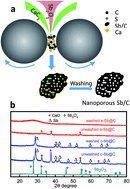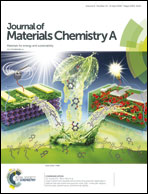A simple synthesis of nanoporous Sb/C with high Sb content and dispersity as an advanced anode for sodium ion batteries†
Abstract
Sodium ion batteries (SIBs) have attracted increasing attention for large-scale energy storage. Among all anodes for SIBs, antimony (Sb) is one of the most attractive ones, but it suffers from a rapid capacity fading because of about 290% volume change upon sodiation/desodiation. Here a facile bottom-up strategy has been developed to prepare nanoporous Sb/C with high Sb content and dispersity via a ball-milling assisted solid state reaction between Sb2O3 and CaC2. The simultaneous and stoichiometric generation of Sb and C facilitates a high dispersion of Sb in, theoretically, 23 wt% carbon. Feeding excess CaC2 can adjust the porosity of the composite, and tailor Sb particles from crystalline (10–20 nm in size) to amorphous (at the subnanometer scale). The synthesized amorphous Sb/C composite exhibits an unprecedented performance for sodium storage. It delivers a high reversible capacity of 480 mA h g−1 at 0.1 A g−1, 403 mA h g−1 after 1000 cycles at 1.0 A g−1, and 283 mA h g−1 after 3000 cycles at 5.0 A g−1. This study may provide a basis for developing high-capacity and long-cycle-life SIBs for practical applications.



 Please wait while we load your content...
Please wait while we load your content...